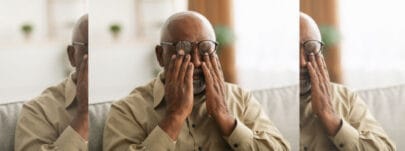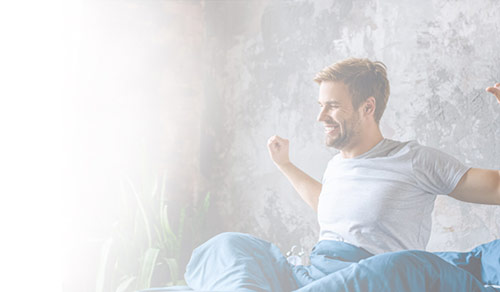
Finding Relief from Dry Eyes Caused by CPAP Devices
One of the most common treatments for obstructive sleep apnea (or OSA) is the use of a CPAP device.
CPAP stands for continuous positive airway pressure — and these machines are designed for precisely that purpose.
Sleep apnea is a condition affecting millions of people globally and is a common sleeping disorder. Obstructive sleep apnea sufferers are briefly woken during sleep as the air passage becomes blocked due to a loosening of the muscles and soft tissue in the throat.
As the body struggles for oxygen, the brain responds by alerting the body to the issue which awakens the sleeper to rectify the problem.
Positive airway pressure devices combat this effect by delivering a steady flow of pressurized air which forces the airway to remain open and free from obstructions.
This form of treatment is considered the most effective method of controlling obstructive sleep apnea. However, one side effect is dry eyes.
What is Dry Eye?
Dry eye is a broad term which encompasses anything that leads to the eyes becoming drier than they should be. The eyes are usually coated with a thin layer of tears which lubricate the surface, which serves to wash away any impurities from the air that may lead to irritation and inflammation.
If the amount of moisture covering the eye is insufficient, this is called “dry eye.” Developing dry eyes from PAP treatment is not uncommon. This is because the pressurized air can leak, affecting the eyes, irrespective whether a full-face mask or a nose mask is being used.
While most OSA sufferers will never experience any issues with their eyes, it can occasionally happen and there are some tell-tale signs to be aware of:
Redness of the eyes
A burning sensation in the eyes
Irritation of the eyes
Blurred or hazy vision
Mucus emanating from the corner of the eyes
Sensitivity to light
Gritty or scratchy feeling on the eyeballs
In addition, many sleep apnea sufferers using PAP devices also have other medical issues. Two of these in particular, Type 2 diabetes and hypertension, can also lead to dry eyes – so they are already at high risk.
What is the Connection?
The onset of dry eyes from PAP therapy can be traced to the pressurized air coming into sustained contact with the eyes. Although the eyes are closed during sleep, the air can reach them and have a drying effect.
This should not occur if the mask is fitted properly and there are no leaks, but this is not always the case.
The mask used should always be a perfect fit and replaced or adjusted. An improperly fitting mask will negate the benefits of the treatment but many people persist with masks that are:
Too big or too small
Loose fitting
Leaking air
Improperly shaped
A correctly fitted mask is crucial to the success of continuous positive airway pressure therapy — and faulty equipment is not an option. Users who suspect there may be an issue with the mask should contact their supplier or sleep specialist and have the problem resolved as speedily as possible.
Prevention
Preventing dry eyes is best done by maintaining the equipment in the best possible condition. This is done by following a logical procedure including:
Ensuring all components are functioning correctly
Carrying out maintenance and cleaning as per the instructions
Making sure the mask fits snugly without air leaks
Not applying moisturizers or gels around the nose or mouth before sleep
If the air being delivered is too dry, it is also possible to use a device with an in-built or attached humidifier which will heat the air and add moisture to the mix.
Also, it is worth trying a lubricant for the eyes — but this should only be done after consultation with a doctor or sleep specialist.
Dry Eye Treatment
Although developing dry eyes from PAP treatment is uncommon, it does happen, and some people are more susceptible than others. If the problem is not due to the device or the mask there are treatments and solutions for the condition:
Eye drops to increase the amount of moisture on the eye surface
Use a room humidifier
Possible medication or prescription drugs
Dry eyes can be caused by certain lifestyle habits.
Increasing the intake of omega 3 fatty acids has been shown to alleviate dry eyes.
Taking breaks if working with a computer screen for prolonged periods will also help.
Also, learning to blink more often can reduce the effects of dry eyes.
Although there is a slight chance of developing dry eyes from PAP therapy, the risk is small and insignificant compared to the benefits of the treatment. Any issues with dry eyes can usually be resolved quickly and easily.
A lack of quality sleep, on the other hand, can have devastating consequences on personal health and quality of life.
Most sleep experts agree that positive airway pressure is the best method of controlling obstructive sleep apnea but even this form of treatment is not without drawbacks.
Dry eyes is a relatively minor, albeit annoying, problem that can be easily corrected by using the device in the correct manner and maintaining the equipment to the proper standard. It may seem like a lot of trouble but the effort is well worth it as a good night’s rest is the overriding aim of such treatment.
Sources:
https://www.healthline.com/health/dry-eye/cpap-dry-eyes
https://www.verywellhealth.com/sleep-apnea-and-eyes-link-conditions-treatment-5216606



